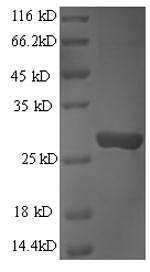Recombinant Human Granzyme B (GZMB) is produced using an E.coli expression system and comprises the full length of the mature protein, spanning amino acids 21-247. The protein comes with an N-terminal 6xHis tag, which makes purification and detection more straightforward. SDS-PAGE analysis confirms a purity level greater than 90%, which appears to provide adequate reliability for research applications. This product is intended for research use only and is not for diagnostic or therapeutic purposes.
Granzyme B is a serine protease that seems to play a central role in triggering apoptosis, particularly in immune cells like cytotoxic T lymphocytes and natural killer cells. It may be critical for immune responses by helping to eliminate infected or cancerous cells. Studies focused on apoptosis, immune regulation, and related pathways often rely on granzyme B's activity to gain insights into cellular mechanisms and identify potential therapeutic targets.
Potential Applications
Note: The applications listed below are based on what we know about this protein's biological functions, published research, and experience from experts in the field. However, we haven't fully tested all of these applications ourselves yet. We'd recommend running some preliminary tests first to make sure they work for your specific research goals.
Based on the provided information, the recombinant Human Granzyme B (GZMB) is expressed in E. coli, a prokaryotic system that is generally unsuitable for producing properly folded and active eukaryotic serine proteases like Granzyme B. Granzyme B requires precise folding, disulfide bond formation, and activation through proteolytic cleavage for its enzymatic activity. E. coli lacks the necessary machinery for proper disulfide bond formation and post-translational modifications. The protein is expressed as the mature form (21-247aa) with an N-terminal 6xHis tag, but without verification of proper folding and activation. Since activity is explicitly unverified, the protein cannot be assumed to be correctly folded or bioactive. Experimental validation is essential to confirm both proper folding and enzymatic activity.
1. Antibody Development and Validation Studies
This application is appropriate. The recombinant GZMB can serve as an effective immunogen for generating antibodies, as antibodies may recognize linear epitopes even if the protein is misfolded. The His-tag facilitates purification and screening. However, if GZMB is misfolded, antibodies may not recognize conformational epitopes of the native, active enzyme. Validation against native Granzyme B from human immune cells is recommended to ensure physiological relevance.
2. Protein-Protein Interaction Studies
This application requires caution. The His-tag enables technical feasibility for pull-down assays, but if GZMB is misfolded, it may not interact physiologically with true binding partners (e.g., perforin or caspase substrates). Identified interactions may be non-physiological. This application should only be pursued after confirming proper folding and enzymatic activity through functional assays.
3. Structural and Biophysical Characterization
This application is well-suited and should be prioritized. Techniques like circular dichroism spectroscopy, dynamic light scattering, and thermal stability assays can directly assess the protein's folding state, oligomerization, and stability. These studies are valuable even if the protein is inactive, as they characterize the recombinant product itself and can inform about its suitability for other applications.
4. Immunoassay Development and Standardization
This application is feasible but requires qualification. The recombinant GZMB can be used as a standard in immunoassays, but if misfolded, it may not accurately represent native Granzyme B in biological samples. The His-tag allows consistent immobilization, but assay results should be validated against active, native Granzyme B to ensure accurate quantification.
Final Recommendation & Action Plan
Given the high probability of misfolding in E. coli for this complex serine protease, recommend first performing comprehensive biophysical and functional validation. This should include: 1) Biophysical characterization (circular dichroism for secondary structure, size-exclusion chromatography for oligomeric state) to assess folding; 2) Functional enzymatic activity assays using synthetic substrates (e.g., Ac-IEPD-pNA) to confirm bioactivity. If validated, the protein can be used for interaction studies and as an immunoassay standard; if not, focus on applications like antibody development and biochemical characterization. For reliable functional studies, consider obtaining Granzyme B from mammalian expression systems that can properly fold and activate this protease. Always include appropriate controls such as active Granzyme B standards in experiments.






